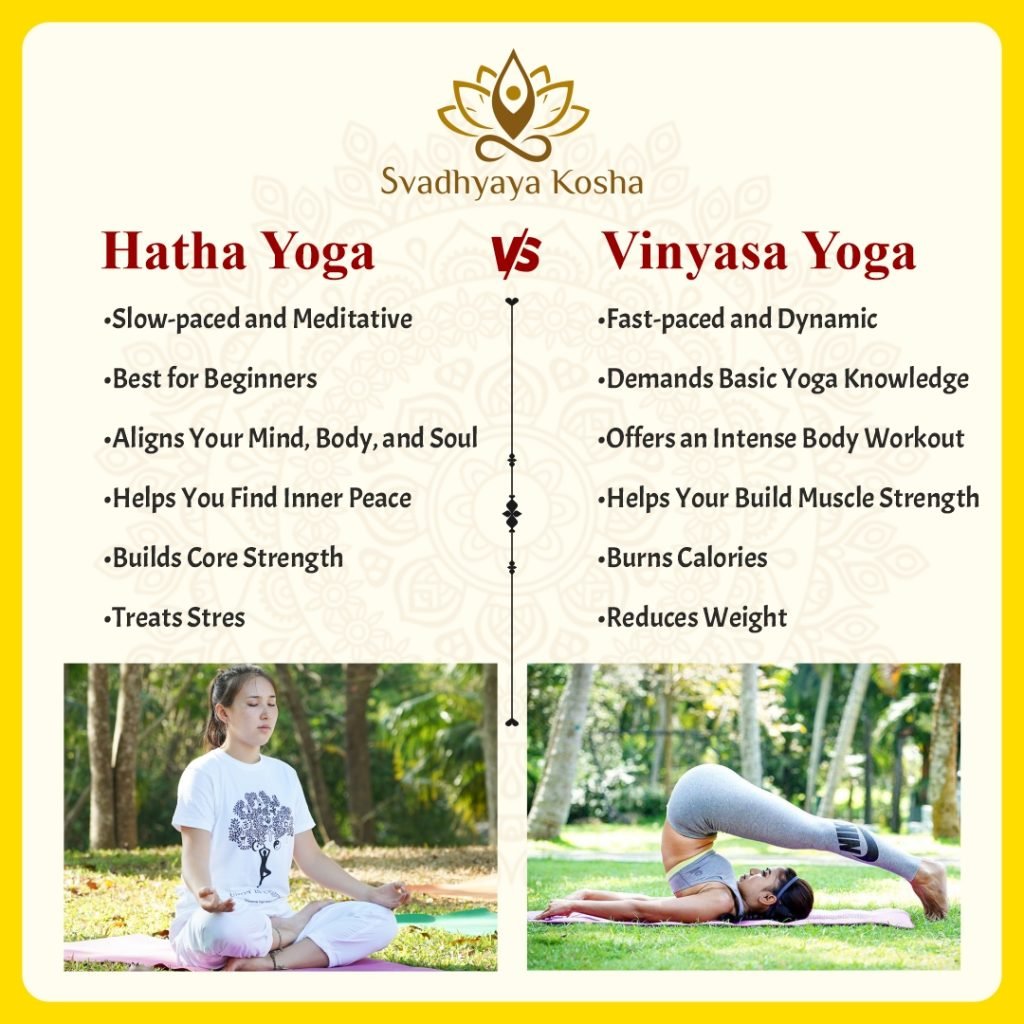Every style of yoga has a purpose reflected in how they are taught. Hatha yoga focuses on mindfulness, emphasizing breath, posture, and meditation. On the other hand, Ashtanga focuses on muscle training and developing physical strength. Lastly, Vinyasa explores the relationship between mind, body, and breath.
Is Ashtanga the hardest yoga?
It is the supreme discipline among yoga styles: Ashtanga yoga. Probably the hardest yoga style, it consists of six series, of which only the first series is often practised over months or years. What Ashtanga yoga actually is, why it is so strenuous and what the Vinyasa Flow is all about, you can find out here!
Is Ashtanga yoga for beginners?
It's the best option for beginners.
In a regular yoga class, a teacher is there to guide the students on how the poses are done for an hour. Ashtanga is a method that follows a system or levels. You are only taught once you're ready.
Can beginners do vinyasa yoga?
Not all vinyasa classes are beginner-friendly.
Slow flow classes are good for beginners because they are taught at a gentler pace that allows you to build body awareness and really learn poses before adding speed, explains Parikh.
Is Vinyasa harder than Ashtanga?
Ashtanga Yoga Is Considered More Difficult
As a result, in addition to the strenuous poses in Ashtanga yoga, every student is encouraged to focus on their power locks, breathing, and gaze point, involving the mind and spirit throughout the practice.
Which is harder Ashtanga or Vinyasa?
Beginners are also introduced to basic yoga postures. Ashtanga yoga is a bit more challenging as it's a faster-paced practice. It's a structured yoga that requires practitioners to move from one pose to the next in a specific order. Vinyasa yoga is considered more physically demanding than the other two styles.
If you are more into a challenging style of yoga, you might want to try this one! #Ashtanga Yoga, another one of the #7TypesOfYoga, comes with great benefits for weight loss & mindfulness. It's a form of Vinyasa yoga that involves a flowing movement of poses.#IDY2022 pic.twitter.com/e342lYHrEs
— YAS Ministry (@YASMinistry) May 20, 2022
What makes Ashtanga yoga different?
Ashtanga is similar to Vinyasa in that it links breath to movement and cycles through different poses, but the difference is that it's composed of six specific pose sequences.
Frequently Asked Questions
Is Ashtanga OK for beginners?
The short answer is yes, Ashtanga yoga as taught in Mysore is a great way to learn any yoga.
Is Ashtanga yoga harder than vinyasa?
Ashtanga Yoga Is Considered More Difficult
As a result, in addition to the strenuous poses in Ashtanga yoga, every student is encouraged to focus on their power locks, breathing, and gaze point, involving the mind and spirit throughout the practice.
Why I don't like Ashtanga yoga?
Physical injury: Ashtanga yoga is a physically demanding practice that involves repetitive movements and can lead to injury if not done properly. Some practitioners may have experienced injuries or pain that led them to quit the practice.
FAQ
- Is Ashtanga yoga hard for beginners?
- Ashtanga yoga can be difficult, so it's best to not overdo it right away. Start small, making sure you understand and are comfortable with each move before trying to do a full session. 2. Practice.
- Which is harder Vinyasa or Ashtanga?
- Ashtanga Yoga Is Considered More Difficult As a result, in addition to the strenuous poses in Ashtanga yoga, every student is encouraged to focus on their power locks, breathing, and gaze point, involving the mind and spirit throughout the practice.
- Are Ashtanga and Vinyasa yoga the same?
- Every style of yoga has a purpose reflected in how they are taught. Hatha yoga focuses on mindfulness, emphasizing breath, posture, and meditation. On the other hand, Ashtanga focuses on muscle training and developing physical strength. Lastly, Vinyasa explores the relationship between mind, body, and breath.
What is the difference between vinyasa and ashtanga yoga
| Is Vinyasa the hardest yoga? | Vinyasa isn't more difficult than any other type of yoga if you choose a class based on your ability and level of fitness. Jump into a random vinyasa class without much yoga experience, and it can be very hard. However, there are steps you can take to adjust the difficulty of the class. |
| Is Ashtanga harder than vinyasa? | Ashtanga Yoga Is Considered More Difficult As a result, in addition to the strenuous poses in Ashtanga yoga, every student is encouraged to focus on their power locks, breathing, and gaze point, involving the mind and spirit throughout the practice. |
- Is Vinyasa yoga ok for beginners?
- In a slower class, the teacher can spend more time helping people into and out of the poses and it can leave more time for talking through how to get into each pose, says Fleming. The slower pace can make this kind of vinyasa yoga more beginner-friendly, she adds.
- Which yoga style for beginners?
- Hatha yoga is always recommended for beginner yogis as it's considered a gentler form of yoga. It is, traditionally, a slower-moving class where you hold each pose for a few breaths while maintaining a focus on improving posture.

